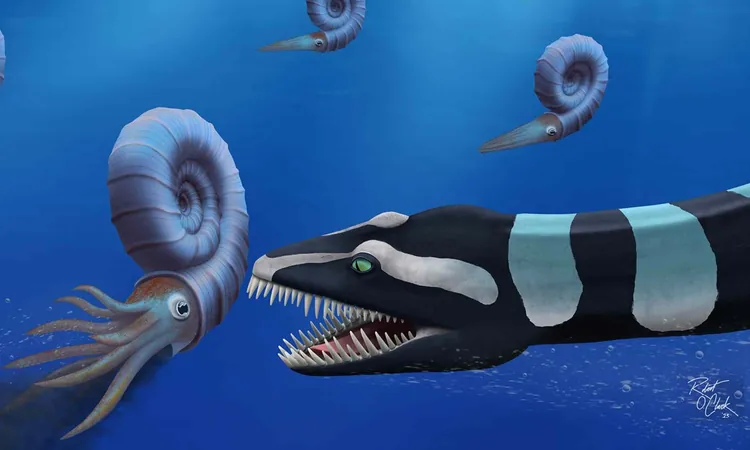
Meet Traskasaura Sandrae: The Newly Discovered Predator of the Ancient Seas!
2025-07-17
Author: Ling
A Stunning Discovery on Vancouver Island
A fossil unearthed back in 1988 on Vancouver Island has revealed an astonishing new species of marine reptile unlike anything we’ve seen before! Known as Traskasaura sandrae, this 39-foot predator roamed our oceans approximately 85 million years ago, and its unique hunting style has left experts buzzing with excitement.
Unraveling the Mystery of Traskasaura Sandrae
Paleontologists struggled to categorize this enigmatic creature due to its peculiar combination of primitive and advanced features. According to Professor F. Robin O’Keefe from Marshall University, who led the research team, it exhibits an extraordinary blend that challenges our understanding of marine reptile evolution!
The Quest for Fossils
The journey to uncover Traskasaura sandrae began at the Haslam Formation, a layer of shale that dates back to a time when shallow seas covered what is now British Columbia. Over three summer excavation seasons, dedicated community volunteers painstakingly excavated a wealth of bones, revealing more than fifty interconnected neck vertebrae.
A Distinctive Hunting Technique
Unlike typical elasmosaurs that snatched fish with sideways sweeps, Traskasaura’s neck joints allowed for an impressive downward flexion. This design, paired with powerful shoulder muscles, suggests it could hover above its prey before diving down with precision—much like a modern heron. Its anatomy hints at a unique ambush strategy never seen in its relatives!
Clues from Skeletal Features
The creature's glenoid cavity, positioned more downward than sideways, allowed for effective propulsion in the water, enhancing its hunting capabilities. Further examination revealed robust conical teeth, perfect for crushing shells, pointing to a diet rich in ammonites—shellfish commonly found in the same geological layers.
A Unique Ecological Niche
During the Late Cretaceous, the waters around what is now Vancouver Island bustled with life, including sleek mosasaurs and sharp-toothed birds. However, Traskasaura sandrae occupied a distinct ecological niche as an opportunistic predator—ambushing prey from above rather than pursuing them in long chases. Its shorter, powerful limbs were tailored for quick, energy-efficient bursts, vital for surviving in nutrient-rich yet cool northern oceans.
Revolutionizing the Plesiosaur Family Tree
Though classified as a plesiosaur, Traskasaura intriguingly positions itself near the base of the elasmosaur lineage, diverging early from southern relatives. This discovery emphasizes the importance of skeletal features in understanding evolutionary relationships, challenging the previous notion that neck length alone defined these creatures.
A Fossil with a Story
Initial finds posed challenges for scientists due to their fragmented nature. However, the uncovering of a more complete skeleton allowed researchers to confidently identify Traskasaura's unique anatomical traits—traits that highlight its place within the rich tapestry of marine life.
Heritage of a Hero
In honoring the legacy of the father-daughter team that discovered the original fossil, Traskasaura combines their surname with the Greek word for lizard. The species name sandrae pays tribute to Sandra Lee O’Keefe, an advocate for breast cancer awareness and someone close to the research team.
A Local Treasure and Ongoing Legacy
Now proudly showcased at the Courtenay and District Museum, this newly identified species resonates deeply with local history. School groups can marvel at vertebrae larger than their hands, imagining the prehistoric predator that once prowled the waters we know today.
This groundbreaking discovery not only adds to regional pride but also underscores the vital role community engagement plays in paleontological research. As the anatomy of Traskasaura sandrae continues to fuel scientific debates, it offers a thrilling glimpse into a world long gone.


 Brasil (PT)
Brasil (PT)
 Canada (EN)
Canada (EN)
 Chile (ES)
Chile (ES)
 Česko (CS)
Česko (CS)
 대한민국 (KO)
대한민국 (KO)
 España (ES)
España (ES)
 France (FR)
France (FR)
 Hong Kong (EN)
Hong Kong (EN)
 Italia (IT)
Italia (IT)
 日本 (JA)
日本 (JA)
 Magyarország (HU)
Magyarország (HU)
 Norge (NO)
Norge (NO)
 Polska (PL)
Polska (PL)
 Schweiz (DE)
Schweiz (DE)
 Singapore (EN)
Singapore (EN)
 Sverige (SV)
Sverige (SV)
 Suomi (FI)
Suomi (FI)
 Türkiye (TR)
Türkiye (TR)
 الإمارات العربية المتحدة (AR)
الإمارات العربية المتحدة (AR)